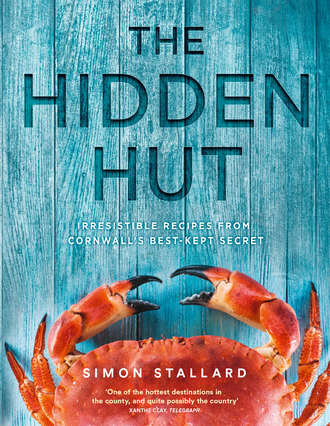
Полная версия
The Hidden Hut: Irresistible Recipes from Cornwall’s Best-kept Secret
Divide the wild garlic among serving bowls and top with the spring onions. Divide the shredded chicken between the bowls and add the herbs.
Taste the broth and check for seasoning, adding more salt and pepper if needed. Ladle it over the chicken and greens in the bowl, and sprinkle over the garlic flowers, if you have them.
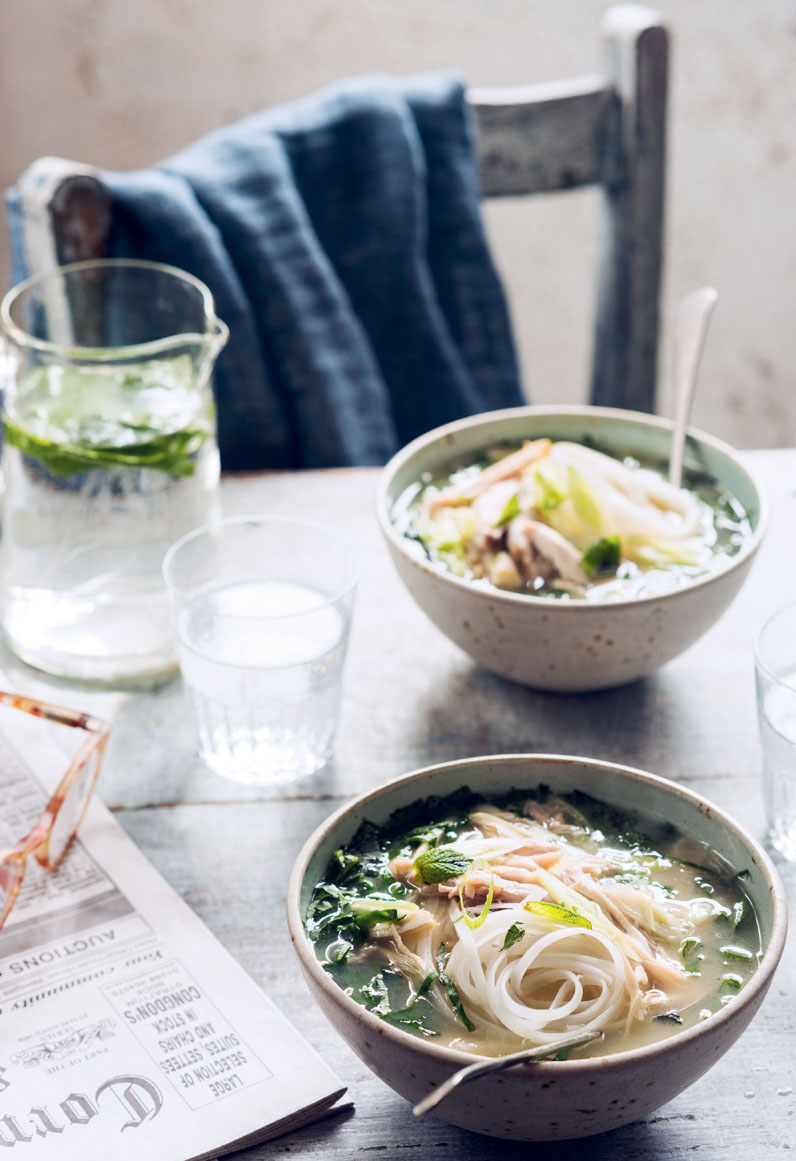
SWEET POTATO CHILLI BOWL
Perfect sustenance after a wintry coastal walk, the sweet potatoes and red lentils in this dish are lifted by the fresh herbs and chillies. It’s a super-tasty veg soup.
Serves 4–6
700g sweet potatoes, peeled and diced into 2.5cm chunks
2 red onions, roughly chopped
4 garlic cloves, chopped
2 tbsp olive oil
100g red lentils
900ml vegetable stock
2 red chillies, deseeded and diced
200ml coconut cream
sea salt and freshly ground black pepper
TO SERVE
4 tbsp flaked almonds
a handful of coriander leaves, roughly chopped
a handful of mint leaves, roughly chopped
1 red chilli, deseeded and finely sliced
2 limes, quartered
Preheat the oven to 200°C (180°C fan oven) gas mark 6. Put the sweet potatoes on a baking tray and add the onions and garlic. Add the oil and toss to coat, then season with salt and pepper. Roast in the oven for 20 minutes.
Put the lentils in a heavy-based saucepan and add the stock and chillies. Bring to the boil, then reduce the heat and simmer for 20 minutes, then blend with a hand blender.
When the roasted vegetables are ready, add them to the lentil pan. Pour in the coconut cream, then return to the boil and simmer lightly for 15 minutes until the vegetables have broken down with the lentils.
Turn up the oven temperature to 220°C (200°C fan oven) gas mark 7 and put the flaked almonds on a baking tray. Toast them in the oven for 2–3 minutes, watching them carefully, until they just start to colour. Take them out and leave the tray one one side.
Serve in soup bowls topped with the fresh herbs, chilli slices, toasted almonds and lime quarters.
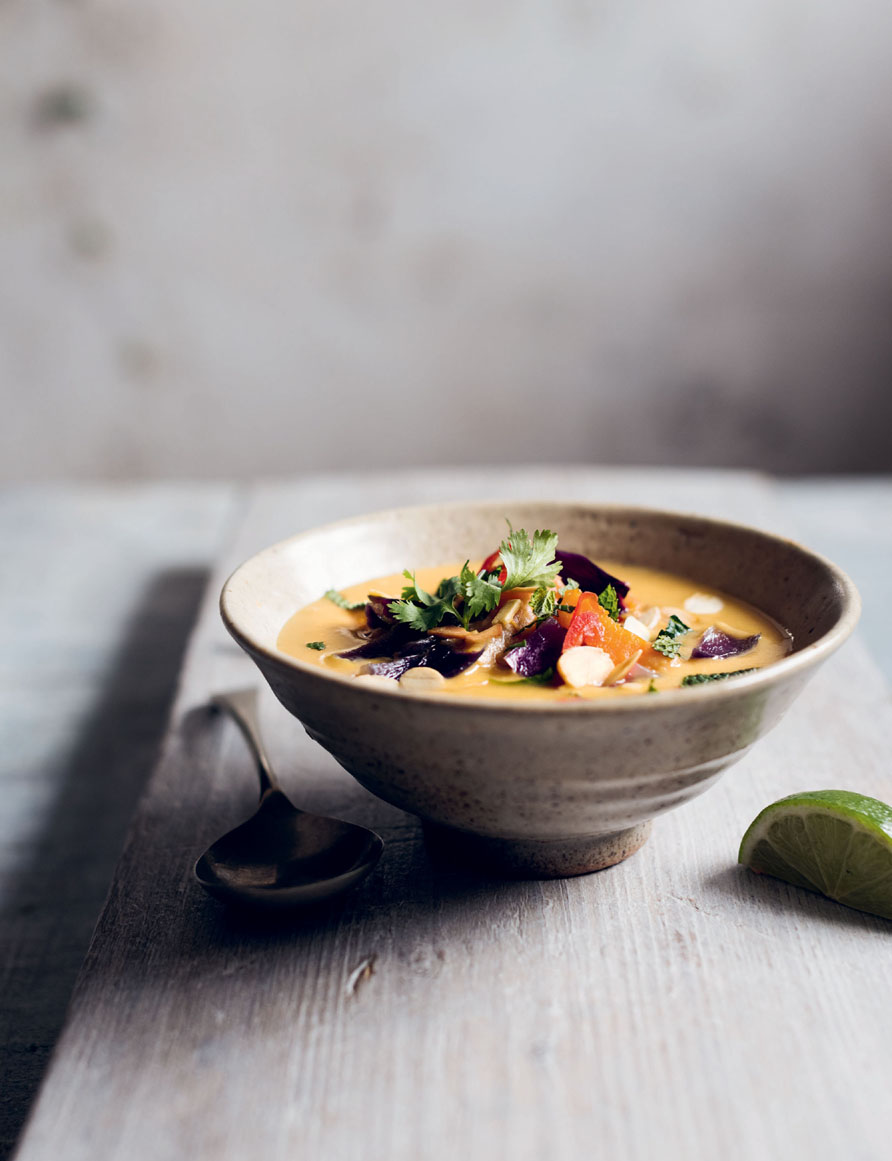
SALT COD AND TOMATO STEW WITH SOURDOUGH TOASTS
Although salting cod sounds technical, it’s so easy and can be done at home overnight. It makes the fish firmer and more versatile to use in dishes where unsalted cod would just disintegrate. It also intensifies the flavour. Tomato and salt cod is a classic combination.
Serves 4–6
350g fine sea salt
3 rosemary sprigs
350g cod fillet, skinned and pin-boned (see tip)
2 tbsp olive oil
1 onion, diced
1 large carrot, diced
1 fennel bulb, diced
3 celery sticks, diced
125ml white wine
1 garlic clove, crushed
400g tin chopped tomatoes
800ml fish stock
¼ tsp smoked paprika
freshly ground black pepper
dill fronds and 4–6 tsp aioli (see here), to serve
FOR THE CROUTONS
10 slices of sourdough bread with crusts, cut into 1.5cm cubes
olive oil, for drizzling
sea salt
Start by salting the cod the day before. Put a good layer of the salt in the base of a shallow dish and add the rosemary. Lay the cod on top and sprinkle over the remaining salt, making sure the fish is completely covered. Cover with cling film and leave for 12 hours in the fridge. (Don’t leave it for longer than this or you will need to soak the fish for longer when you come to use it.)
The next day, thoroughly rinse the salt from the cod. Put the cod in a large bowl and cover with plenty of fresh cold water, then leave it to soak for 10 minutes before draining. Preheat the oven to 220°C (200°C fan oven) gas mark 7.
Heat the oil in a large saucepan over a medium heat and cook the onion, carrot, fennel and celery. Add the wine and garlic, then simmer to reduce the liquid slightly. Add the tomatoes and bring to the boil. Pour in the stock and return to the boil, then reduce the heat and simmer for 20 minutes or until the vegetables are tender.
Stir in the paprika and season with pepper. Add the cod and leave it to cook and start to break up in the soup — this shouldn’t take more than 2–3 minutes. Remove the pan from the heat and leave it to stand for 5 minutes.
Meanwhile, to make the croutons, spread out the bread on a baking tray. Drizzle with olive oil and a light sprinkling of salt. Put them in the hot oven and bake for 3 minutes. Remove from the oven and toss them so that they brown evenly. Return to the oven to bake for a further 3 minutes or until golden. Serve the soup with the croutons and dill fronds on top and a teaspoon of aioli per bowl.
Pin-boning
Tiny bones, known as pin bones, will spoil your experience of eating fish if they are left in. To remove them, use standard tweezers or special fish tweezers. First run your fingers over the fish to locate the bones, which are hidden just beneath the surface. They lie at an angle, so you’ll need to grab the end with the tweezers and pull the bones upwards and sideways to remove them.
GREEN PEA SOUP WITH LEMON AND RICOTTA
Fresh peas are best in the late spring and early summer, though by using frozen peas this soup can be enjoyed at any time of the year. The recipe is very simple and takes less than 15 minutes to make.
Serves 4
750ml vegetable stock
700g fresh podded peas (or frozen peas)
4 tbsp ricotta cheese
zest of ½ lemon
75ml double cream
20g mint leaves, shredded
sea salt and freshly ground black pepper
Put the vegetable stock in a large saucepan over a high heat and bring it to a rolling boil, then add the peas. Simmer for 8–10 minutes, or until the peas are tender. (If using frozen peas, cook from frozen and simmer for about 5 minutes).
Meanwhile, mix the ricotta and lemon zest together in a small bowl.
Once the peas are cooked, remove the pan from the heat and stir in the cream and most of the mint leaves. Blend the soup in a blender or food processor, then season to taste with salt and pepper.
Divide the soup between four bowls and serve each topped with a tablespoon of the lemon ricotta and a few of the reserved mint leaves sprinkled over.
ST MAWES SMOKED HADDOCK CHOWDER
There is nearly always a pan of St Mawes Smoked Haddock Chowder cooking on the stove at the Hidden Hut, come rain or shine. More substantial than a soup, this chowder will serve up to six people with a good helping of bread on the side.
Serves 4–6
400g smoked haddock, with skin, pin-boned (see here)
1 bay leaf
1 litre whole milk
2 tbsp light olive oil
6 rashers of smoked streaky bacon, sliced
50g butter
2 onions, diced
3 celery sticks, diced
½ fennel bulb, diced
4 garlic cloves, crushed
50g plain flour
400g waxy potatoes, peeled and diced
300ml fish stock
165g tinned sweetcorn
3 tbsp chopped dill fronds
zest and juice of 1 lemon
sea salt and freshly ground black pepper
1 spring onion, finely chopped, to garnish
FOR THE CROUTONS
80g bread with crusts, cut into 1.5cm cubes
2 tbsp olive oil
Preheat the oven to 200°C (180°C fan oven) gas mark 6. First prepare the croutons. Spread out the bread on a baking tray. Drizzle with the olive oil and add a light sprinkling of salt. Bake for 3 minutes then remove from the oven and toss so that they brown evenly. Return to the oven for a further 3 minutes or until golden. Put to one side.
Now for the chowder. Put the haddock and bay leaf in a roasting tin and pour over the milk. Cover with foil and bake for 12 minutes. Discard the bay leaf, peel the skin from the haddock and flake the flesh into a bowl. Set aside and reserve the cooking milk.
Add the oil to a large saucepan over a medium-high heat and get it really hot. Fry the bacon until golden and crispy. Turn the heat down, add the butter and let it melt. Add the onions, celery, fennel and garlic, and sweat them in the butter until tender and translucent. Add the flour and cook for 2 minutes, stirring, to cook out the taste of the flour. Then, bit by bit, add the reserved cooking milk, stirring to make a thick sauce. Leave to cook over a very low heat.
Meanwhile, put the potatoes in a saucepan, add the fish stock and bring to the boil. Cook for 8 minutes, then transfer the potatoes and stock to the gently simmering chowder base.
Finally, add the smoked haddock, sweetcorn, dill and lemon zest and juice and season to taste. Cook for 2 minutes more to let the flavours combine. Garnish with the croutons and chopped spring onion, and serve immediately.

A LITTLE LOBSTER GOES A LONG WAY
Lobsters are a luxury item and this is all about getting the most out of your catch or purchase. It is a way of serving four people a thoughtful two-course lunch using just two lobsters. Start with the summer vegetable cigars and tarragon dip, then finish with the velvety bisque and toasts.
FEAST
Serves 4
2 live or cooked cold-water lobsters
sea salt and freshly ground black pepper
FOR THE LOBSTER BISQUE
2 tbsp olive oil
50g butter
4 celery sticks, sliced
5 garlic cloves, chopped
2 onions, chopped
½ fennel bulb, sliced
1 red chilli, deseeded and chopped
½ tsp coriander seeds
¼ tsp fennel seeds
1 star anise
2 tbsp tomato purée
100ml Pernod
300ml white wine
2 litres fish stock
2 bay leaves
zest of 1 lemon and juice of ½ lemon
50g tarragon sprigs
2 tbsp double cream
FOR THE LOBSTER CLAW TOASTS
zest of ½ lemon
1 spring onion
a small handful of chives
1 large egg
2 slices of white sourdough bread or 1 huge slice
sunflower oil, for shallow-frying
FOR THE TARRAGON DIP
6 tbsp mayonnaise
6 tbsp crème fraîche
zest and juice of 2 limes
a handful of tarragon sprigs, leaves roughly chopped
FOR THE SUMMER VEGETABLE AND LOBSTER CIGARS
zest and juice of 1 lime
1 small mint sprig, leaves shredded
4 sheets of spring roll pastry
1 courgette, cut into thin strips
1 egg, beaten
sunflower oil, for deep-frying
If you’ve caught your own lobsters or are buying live ones, you’ll need to kill them before cooking. Put the live lobsters into the freezer for 30 minutes to sedate them. Once sedated, lie one flat, stomach side down, on a chopping board. Spike it firmly and quickly with a large sharp knife in the base of its head and swiftly cut straight down. Repeat with the other lobster. They are now ready to cook.
Fill a large saucepan with water and bring to the boil with a large pinch of salt. Once boiling, add the lobsters and set the timer to boil for 8 minutes. Remove the lobsters from the pan and refresh in iced water. Now continue with the preparation for cooked lobsters.
If you’re buying cooked lobsters, start here. Separate the claws and tail from the body: this can be done simply by twisting them. Now it’s time to pick out the tail meat. Try to keep it whole and pull it out in one piece, cutting down the back and discarding the intestinal vein. Put it onto a plate. Crack the claws with a nutcracker and pick the meat out into a bowl. Reserve the body shells. You are now ready to start cooking the different dishes.
To make the lobster bisque, heat the oil and butter in a large saucepan over a high heat and fry the lobster body shells for 5 minutes or until coloured and fragrant. Remove the shells and add the celery, garlic, onions, fennel, chilli and spices, then cook over a low heat for 5 minutes.
Add the tomato purée and cook for 1 minute. Then deglaze the pan with the Pernod, stirring to pick up the flavours in the pan. Add the wine and stock, then return the lobster body shells to the pan. Add the bay leaves, lemon zest and tarragon, and cook over a low heat for 30 minutes.
Pass the liquid through a fine sieve, discarding the other ingredients, then return it to the pan and cook over a high heat to reduce it by about one-quarter; this will take about 5 minutes. Stir in the cream and lemon juice, and season with salt and pepper to taste. Keep aside until ready to serve.
To make the lobster claw toasts, put the claw meat in the bowl of a food processor and add the lemon zest, spring onion, chives and egg. Season with salt and pepper, then blitz. (Alternatively, chop the ingredients finely using a sharp knife, then put in a bowl. Beat the egg and stir it in.) Spread this wet mix on top of the bread slices.
Add the oil to a depth of 1cm in a large frying pan and heat until hot. Fry the toasts, lobster side down first. Turn over after 1 minute and fry for another 1 minute on the other side until golden. Put to one side until ready to serve.
To make the tarragon dip, put the mayonnaise and crème fraîche in a bowl and add the lime zest and juice and the tarragon. Mix well and season to taste with salt and pepper.
To make the summer vegetable and lobster cigars, shred the tail meat lengthways into long strips and place in a bowl. Add the lime zest and juice and the mint, and season with salt and pepper. Put to one side.
Lay out the spring roll pastry sheets, then cut each square in half diagonally to make eight triangles. Put the shredded lobster meat and courgette strips on the wide side of each triangle, then brush the edges of the pastry with the egg and roll up. Fold over the ends to close. The rolls are now ready to fry.
Fill a deep-fryer or a large heavy-based saucepan one-third full with oil and heat it to 175°C (test by frying a small cube of bread; it should brown in 40 seconds). Add the rolls and fry until golden. Serve the lobster cigars alongside the tarragon dip as a starter. Then when you’re ready for the bisque, warm it up on the stove and heat the toasts in a preheated oven for a few minutes so they are warm and crispy to serve.
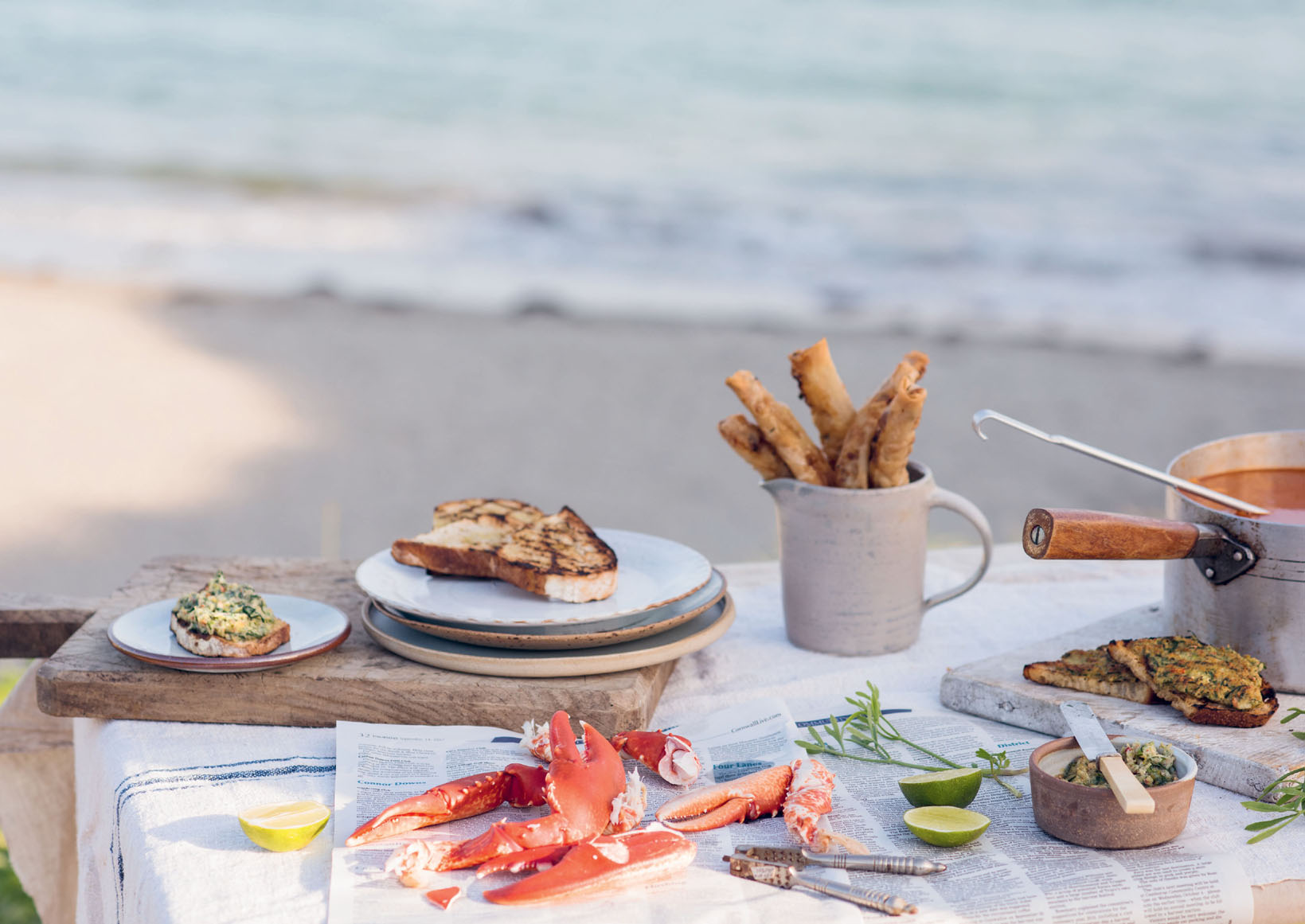
WEST BRITON CRAB CLAWS WITH LEMON AND GARLIC BROTH
A fabulously messy thing to eat, these claws are served on a thick base of newspaper (the West Briton is particularly good!) with a hammer, a shellfish pick, a bucket for the shells and a bowl of lemon water for rinsing your hands.
Serves 4
1kg cooked crab claws
200g butter, softened
5 garlic cloves, crushed
a handful of parsley leaves, chopped
3 tbsp olive oil
crusty bread, to serve
newspaper (West Briton ideally!), a hammer, or nut crackers, and shellfish picks or skewers
FOR THE BROTH
200g butter
5 garlic cloves, crushed
1 lemon, cut into 8 wedges
2 bay leaves
200ml white wine
20g tarragon sprigs
10 black peppercorns
10 coriander seeds
2 tbsp sea salt
First, make the broth. Take a large saucepan that will hold the claws, add the butter and melt it over a medium heat. Add the garlic, lemon and bay leaves, and cook until the garlic just starts to colour. Pour in the wine and cook until reduced by half and there is no smell of alcohol. Add the remaining broth ingredients and 300ml water, then bring to the boil. Reduce the heat to a simmer and cook for 5 minutes.
Increase the heat to bring the broth to a gentle boil, then add the crab claws and return to the boil. Reduce the heat and simmer for 5 minutes to heat through.
Transfer the crab claws and broth to a large serving bowl. Put the butter in a separate bowl and add the garlic, parsley and olive oil. Mix together well, then spoon over the hot crab claws and broth to make a buttery sauce.
Cover your table with sheets of the newspaper of your choice and put the bowl of crab claws and broth in the middle. You will also need a small hammer or nut crackers, a bucket for the shells and a bowl of lemon water for rinsing your hands.
To eat, scoop the crab claws out of the broth and crack with the hammer using just enough pressure to crack the shell without shattering it into lots of small pieces. Pull out the meat using the hard cartilage in the centre of the claw to help; if you are lucky it will come out in one piece. Alternatively, extract or pick out the meat using a shellfish pick or skewer. Mop up the buttery cooking broth with plenty of crusty bread.
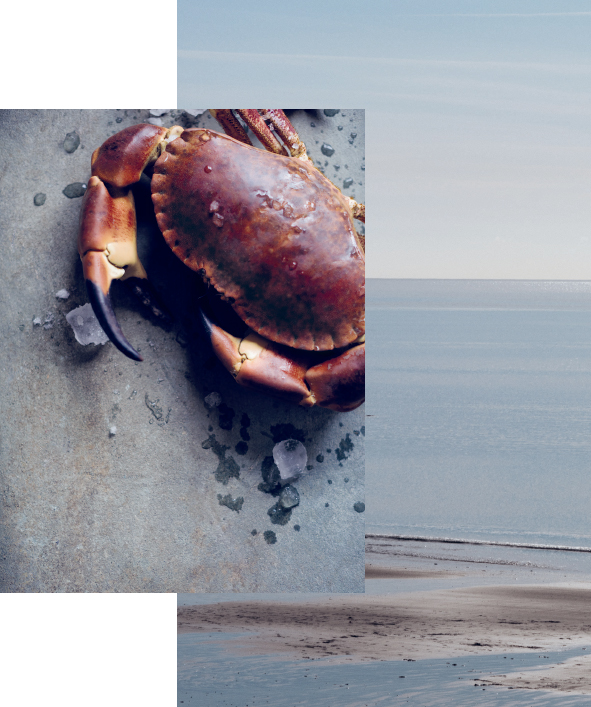
FRITTO MISTO
There are no rules as to what you fry when making a fritto misto — it’s about a collection of flavours and textures. I’ve added some seafood here, but you can keep it veggie if you prefer. If you do include seafood in your fritto misto, put some aioli (see here) out on the table too.
Serves 4
sunflower oil, for deep-frying
1 small butternut squash, peeled, deseeded and finely sliced lengthways
1 fennel bulb, finely sliced lengthways
1 red onion, finely sliced lengthways
2 red peppers, deseeded and finely sliced lengthways
500g squid, cleaned, body sliced into fine rings and tentacles left whole
1 lemon, finely sliced into rings
a handful of drained tinned chickpeas, rinsed
1 chilli, finely chopped
a handful of mixed soft herbs
sea salt and freshly ground black pepper
2 lemons, cut into wedges, to serve
FOR THE BATTER
125g cornflour
125g plain flour
1 tsp baking powder
a pinch of sea salt
juice of 1 lemon
To make the batter, sift the dry ingredients into a bowl. Slowly add 275ml cold water while whisking to form a lump-free batter. Add the lemon juice and whisk once more. Put to one side while you prep your veg.
Fill a deep-fryer or a heavy-based saucepan one-third full with oil and heat it to 180°C (test by frying a small cube of bread; it should brown in 40 seconds). Dip the squash slices into the batter and then lower each one carefully into the hot oil. Cook for 3 minutes or until they start to caramelise then lift out of the pan using a slotted spoon and drain off the excess oil. Place on a few sheets of kitchen paper and dab dry.
Batter and cook the remaining vegetables, squid, lemon slices, chickpeas and chilli in the same way, although the softer ingredients will take slightly less time: 1–2 minutes.
Batter and fry the herbs separately — they will take less than a minute. Season all the battered ingredients with salt and pepper. Serve as a beautiful stack in the centre of the table, with wedges of lemon.
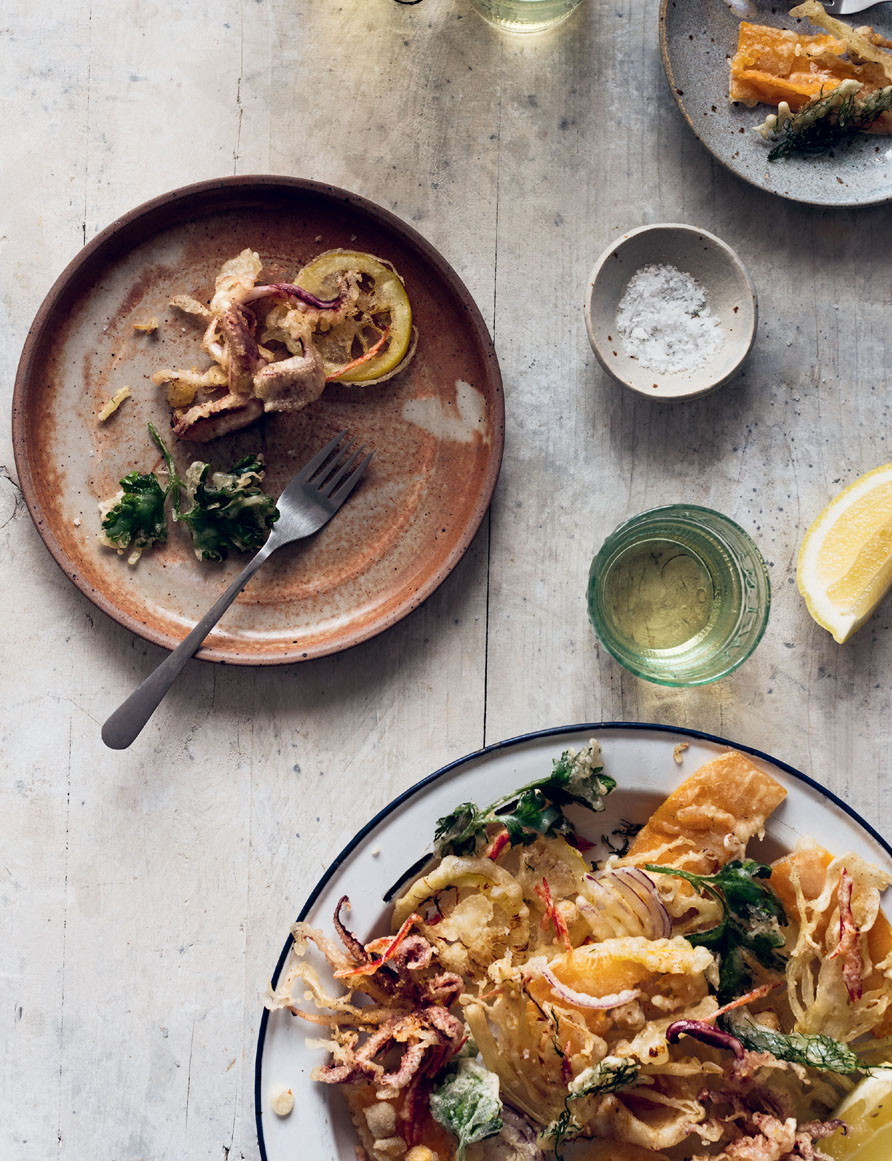
SCALLOP SALAD WITH HOG’S PUDDING, GINGERED PEAR AND WATERCRESS SALAD
Here is a classy lunch that is surprisingly simple to achieve. The flavours in this salad are quintessentially Cornish with the salty hog’s pudding and the delicate umami of the local scallops. The sweet and bitter notes of the gingered pear and watercress bring it all together. It is great with a glass of Camel Valley fizz.
Serves 4
2 pears, peeled, quartered and cored
a squeeze of lemon juice
sunflower oil, for frying
100g hog’s pudding, cut into matchsticks
12 Cornish king scallops, corals removed and discarded and white meat halved horizontally
100g watercress, thick stalks discarded
FOR THE DRESSING
10g piece of fresh root ginger, peeled and grated
2 tbsp orange juice
½ tsp Dijon mustard
1 tbsp mild olive oil
sea salt and freshly ground black pepper
Конец ознакомительного фрагмента.
Текст предоставлен ООО «ЛитРес».
Прочитайте эту книгу целиком, купив полную легальную версию на ЛитРес.
Безопасно оплатить книгу можно банковской картой Visa, MasterCard, Maestro, со счета мобильного телефона, с платежного терминала, в салоне МТС или Связной, через PayPal, WebMoney, Яндекс.Деньги, QIWI Кошелек, бонусными картами или другим удобным Вам способом.


